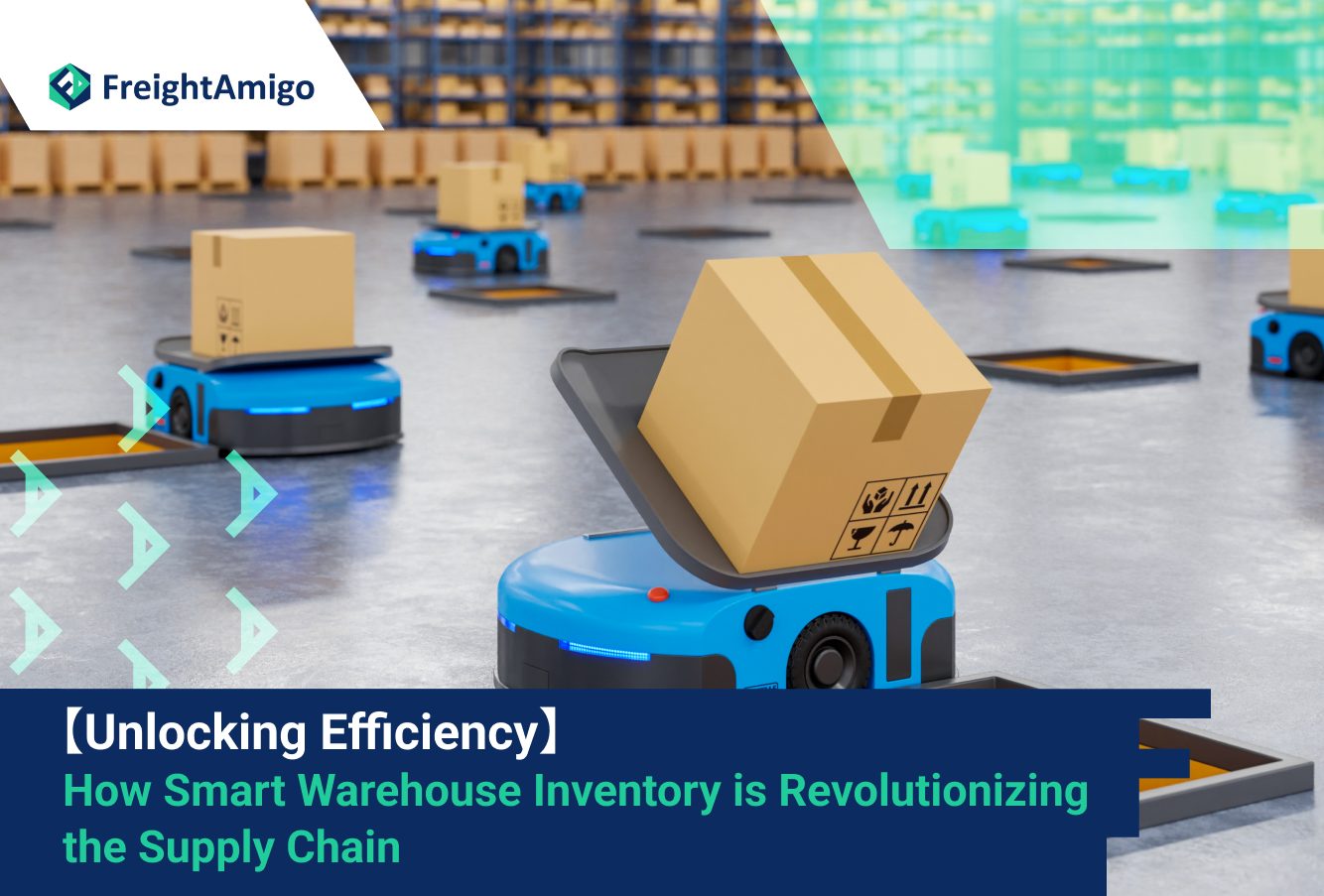December 27th, 2023: Caspian Ng – Marketing Analyst at FreightAmigo
Introduction to smart warehouse inventory
In today’s fast-paced and highly competitive business landscape, efficiency is paramount for any company looking to stay ahead of the game. One area where efficiency plays a critical role is in the supply chain. Smooth and streamlined warehouse operations are essential for ensuring timely deliveries, reducing costs, and maximizing customer satisfaction. This is where smart warehouse inventory systems come into play, revolutionizing the traditional supply chain management process.
A smart warehouse inventory system leverages the power of advanced technologies such as the Internet of Things (IoT), artificial intelligence (AI), and automated guided vehicles (AGVs) to optimize warehouse operations. By integrating these technologies, companies can gain real-time visibility into their inventory, automate tedious tasks, and make data-driven decisions. From accurate inventory tracking to efficient order fulfillment, a smart warehouse inventory system brings numerous benefits to the supply chain.
Want to compare the best Express, Air Freight, Sea Freight, Rail Freight & Trucking rates so as to have better control on cost?
The key components of a smart warehouse
To understand how a smart warehouse inventory system functions, it is crucial to delve into its key components. Firstly, IoT devices play a pivotal role in collecting and transmitting data. These devices, such as sensors and RFID tags, are strategically placed throughout the warehouse to track inventory movement, monitor environmental conditions, and enable seamless communication between various systems.
Next, artificial intelligence acts as the brain behind a smart warehouse inventory system. AI algorithms analyze the vast amounts of data collected by IoT devices, providing valuable insights and predictions. By leveraging machine learning, AI can optimize inventory placement, forecast demand patterns, and even automate certain decision-making processes.
Additionally, warehouse management systems (WMS) act as the central hub for all operations. A WMS integrates with IoT devices, AI algorithms, and other software applications to streamline inventory management, order processing, and logistics. It serves as the backbone of the smart warehouse, ensuring that all components work harmoniously together.
Benefits of implementing smart warehouse inventory systems
Implementing a smart warehouse inventory system brings a multitude of benefits to the supply chain. Firstly, it significantly improves inventory accuracy. By leveraging IoT devices and AI algorithms, companies can track inventory in real-time, reduce stockouts, and minimize overstocking. This level of accuracy reduces costs associated with lost or misplaced inventory and enhances customer satisfaction by ensuring products are always available.
Secondly, a smart warehouse inventory system enhances operational efficiency. With automated processes and real-time data insights, companies can optimize warehouse layouts, reduce travel time, and improve overall productivity. AI algorithms can also optimize picking routes, minimizing errors and reducing the time it takes to fulfill orders. These efficiency gains translate into faster order processing, shorter lead times, and ultimately, happier customers.
Furthermore, a smart warehouse inventory system enables better demand forecasting and inventory planning. By analyzing historical data and real-time market trends, AI algorithms can accurately predict demand patterns and adjust inventory levels accordingly. This proactive approach minimizes the risk of stockouts or excess inventory, leading to improved cash flow and reduced holding costs.
The role of the Internet of Things (IoT) in smart warehouse inventory
The Internet of Things (IoT) is a game-changer when it comes to smart warehouse inventory systems. IoT devices, such as sensors and RFID tags, enable seamless connectivity and data exchange between various components of the warehouse. These devices can track inventory movement, monitor temperature and humidity levels, and even detect equipment malfunctions.
By leveraging IoT, companies can achieve real-time visibility into their inventory. They can monitor stock levels, identify bottlenecks, and proactively address any issues that may arise. For example, if a sensor detects a temperature increase in the warehouse, it can trigger an alert to the appropriate personnel, allowing them to take immediate action and prevent potential damage to perishable goods.
IoT devices also enable the automation of routine tasks. For instance, automated inventory counting can be achieved by deploying RFID tags on products and using RFID readers to scan them. This process eliminates the need for manual counts, reducing human error and freeing up employees’ time for more value-added activities.
How artificial intelligence is revolutionizing warehouse management systems
Artificial intelligence (AI) is revolutionizing warehouse management systems by enabling automation, optimization, and predictive analytics. AI algorithms can analyze vast amounts of data collected by IoT devices and other sources, providing valuable insights and recommendations for improving warehouse operations.
One area where AI has made significant strides is in optimizing inventory placement. By analyzing historical sales data, customer preferences, and market trends, AI algorithms can determine the most efficient placement of products within the warehouse. This optimization minimizes travel time, reduces picking errors, and maximizes space utilization.
AI algorithms also play a vital role in demand forecasting. By analyzing historical sales data, seasonality patterns, and external factors such as weather or economic indicators, AI can accurately predict future demand. This allows companies to adjust inventory levels accordingly, ensuring they have the right products in stock at the right time.
Furthermore, AI-powered predictive analytics can identify potential issues before they occur. For example, by analyzing equipment data collected by IoT devices, AI algorithms can detect patterns indicative of equipment failures. This enables proactive maintenance, reducing downtime and minimizing the impact on warehouse operations.
The use of automated guided vehicles (AGV) in smart warehouses
Automated guided vehicles (AGVs) are a key component of smart warehouse inventory systems. These autonomous vehicles navigate the warehouse floor, transporting goods from one location to another without human intervention. AGVs can be equipped with sensors and cameras, allowing them to detect obstacles and navigate safely in dynamic environments.
The use of AGVs brings numerous benefits to warehouse operations. Firstly, they enhance efficiency by reducing the time and labor required for manual material handling. AGVs can transport heavy or bulky items that would otherwise require multiple employees. This frees up human resources for more complex tasks, such as quality control or order fulfillment.
Secondly, AGVs improve safety in the warehouse. By eliminating the need for human-operated forklifts or pallet jacks, the risk of accidents and injuries is significantly reduced. AGVs are programmed to adhere to strict safety protocols, ensuring a safe working environment for all employees.
Moreover, AGVs contribute to better inventory accuracy. They can be integrated with the warehouse management system, allowing for real-time tracking of goods as they move throughout the facility. This visibility enables accurate inventory counts, reduces the risk of lost or misplaced items, and enhances overall inventory management.
Automated picking tools and their impact on warehouse efficiency
Automated picking tools are another critical component of smart warehouse inventory systems. These tools leverage advanced technologies such as robotics, AI, and machine vision to automate the order picking process, improving efficiency and accuracy.
One common automated picking tool is the use of robotic arms. These arms can be programmed to pick products from shelves or bins and place them into designated containers or pallets. By eliminating the need for manual picking, companies can significantly reduce errors and increase throughput.
Another automated picking tool is the use of pick-to-light systems. These systems utilize light indicators to guide warehouse personnel to the correct location and quantity of items to be picked. Pick-to-light systems reduce picking errors and increase productivity by providing clear instructions to employees.
Machine vision technology is also widely used in automated picking. By using cameras and image recognition algorithms, machines can identify and locate products within the warehouse. This enables automated sorting, picking, and packing processes, reducing human error and improving overall efficiency.
Automated picking tools not only improve accuracy but also increase order fulfillment speed. By automating the picking process, companies can fulfill orders faster, reducing lead times and enhancing customer satisfaction. Additionally, automated picking tools can be seamlessly integrated with other components of the smart warehouse, such as AGVs, to create a fully automated and efficient operation.
Considerations for implementing a smart warehouse inventory system
While the benefits of implementing a smart warehouse inventory system are clear, there are several considerations that companies should keep in mind before embarking on this journey.
Firstly, it is essential to assess the current state of the warehouse and identify areas that would benefit the most from automation. Conducting a thorough analysis of existing processes, workflows, and pain points will help determine which technologies and solutions are most suitable.
Secondly, companies should carefully evaluate the costs associated with implementing a smart warehouse inventory system. While the long-term benefits may outweigh the initial investment, it is crucial to have a clear understanding of the financial implications. This includes not only the cost of hardware and software but also training, maintenance, and ongoing support.
Additionally, companies should consider the scalability and flexibility of the chosen solution. As business needs evolve, the smart warehouse inventory system should be able to adapt and grow with the company. Scalability ensures that the system can handle increased volumes and complexity without significant disruptions.
Furthermore, data security and privacy should be top priorities when implementing a smart warehouse inventory system. With the vast amount of data collected and transmitted, it is crucial to have robust security measures in place to protect against cyber threats and unauthorized access.
Lastly, change management and employee training are critical for a successful implementation. Employees should be involved in the process from the beginning and provided with the necessary training to understand and embrace the new technologies. Change management strategies should be implemented to ensure a smooth transition and minimize resistance to change.
Conclusion: The future of smart warehouse inventory in the supply chain
In conclusion, smart warehouse inventory systems are revolutionizing the supply chain by unlocking efficiency and optimizing warehouse operations. By integrating advanced technologies such as IoT, AI, AGVs, and automated picking tools, companies can achieve real-time visibility into their inventory, improve operational efficiency, and make data-driven decisions.
The benefits of implementing a smart warehouse inventory system are numerous, from improved inventory accuracy and operational efficiency to better demand forecasting and inventory planning. IoT devices play a crucial role in collecting and transmitting data, while AI algorithms provide valuable insights and recommendations. AGVs and automated picking tools further enhance efficiency and accuracy in the warehouse.
However, implementing a smart warehouse inventory system requires careful consideration of various factors, including existing processes, costs, scalability, data security, and change management. By addressing these considerations, companies can successfully implement a smart warehouse inventory system and reap the benefits it brings to the supply chain.
As the business landscape continues to evolve, smart warehouse inventory systems will play an increasingly important role in ensuring competitive advantage and customer satisfaction. Embracing these technologies and harnessing their full potential will position companies at the forefront of the industry, unlocking efficiency in the supply chain like never before.
There are different options for cargo transportation. If you want to choose the most convenient and suitable solution, it is best to have the full support of logistics experts! If you are planning to ship goods overseas, please go to the FreightAmigo page for inquiries.
===
Read More:
Guide to Tariffs in Hong Kong | Things You Need to Know
===
If you have any inquiries on logistics/supply chain, feel free to contact FreightAmigo now:
Chat with us online OR
Phone : +852 28121686
WhatsApp: +852 27467829









































